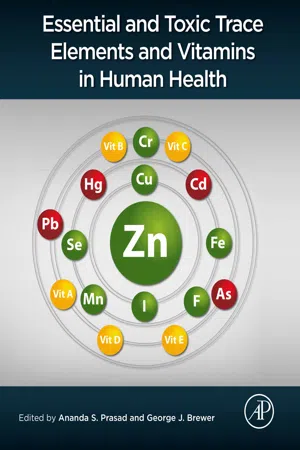
Essential and Toxic Trace Elements and Vitamins in Human Health
- 326 pages
- English
- ePUB (mobile friendly)
- Available on iOS & Android
Essential and Toxic Trace Elements and Vitamins in Human Health
About This Book
Essential and Toxic Trace Elements and Vitamins in Human Health is a comprehensive guide to the wide variety of micronutrients that affect human health, including fat-soluble and water-soluble vitamins that support diverse biochemical functions, trace elements with established and suggested links to health maintenance, and elements with known human toxicity such as arsenic, cadmium, and lead.
An essential reference text for nutritionists working in academia and functional food and supplement industries, dieticians, and clinicians, Essential and Toxic Trace Elements and Vitamins in Human Health provides an in-depth look at toxic trace elements and essential vitamins and minerals and their direct influence on the body's overall health with expert research from renowned scientists.
- Presents a balanced scientific view of essential and nonessential micronutrients with an in-depth analysis of the biochemical functions each plays in human health
- Examines particular micronutrients in detail with coverage of clinical aspects, interaction with other micronutrients, immunological effects, cognitive functions and epigenetics
- Focuses on effective management of micronutrient deficiencies and on toxicity implications of overexposure
Frequently asked questions
Information
Clinical and immunological effects and biomarkers of zinc deficiency
Abstract
Keywords
1 Introduction
2 Discovery of zinc deficiency in human
2.1 Studies in Iran

Table of contents
- Cover image
- Title page
- Table of Contents
- Copyright
- Contributors
- Acknowledgments
- Periodic table of the elements
- Introduction
- Part I: Essential
- Part II: Toxic trace elements
- Part III: Vitamins
- Recommended daily dietary allowances
- Index